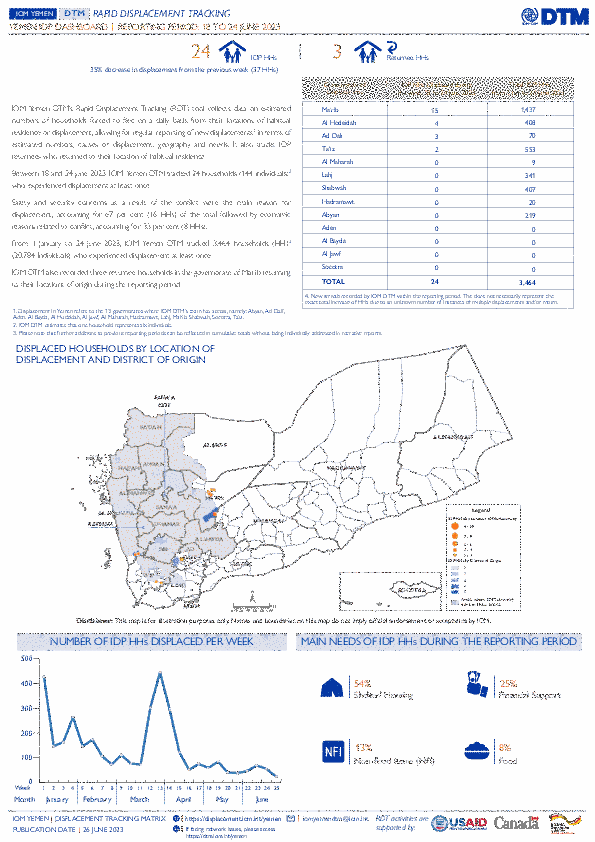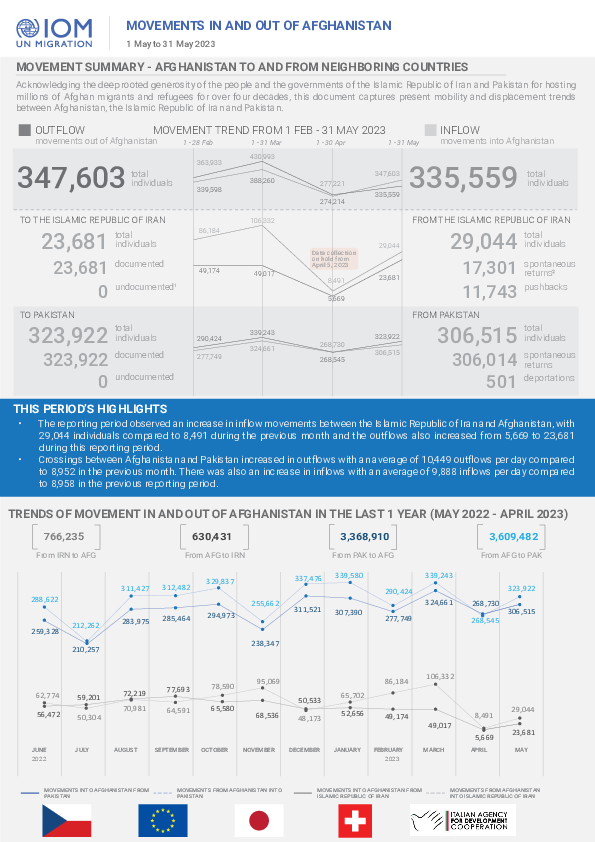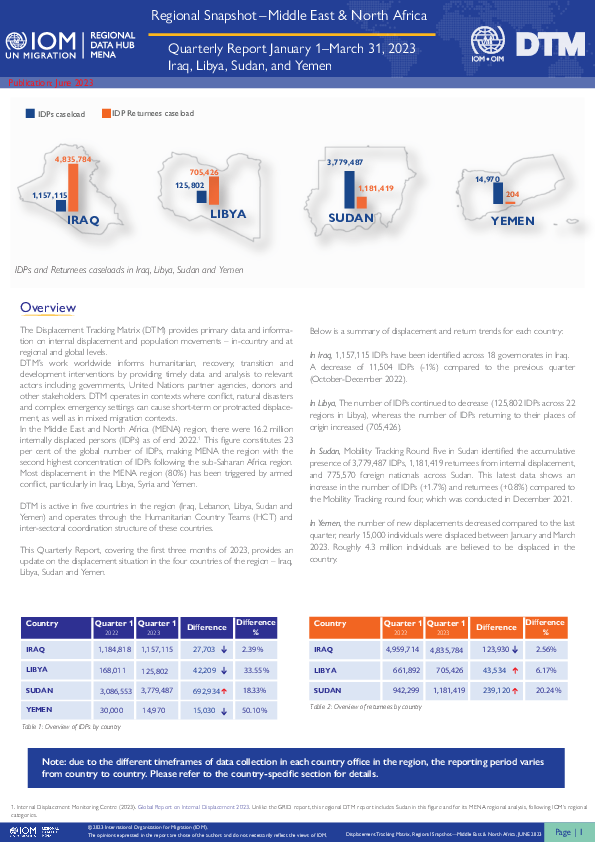-
Countries
-
Data and Analysis
-
Special Focus
-
Crisis Responses
Contact
DTM Yemen, iomyemendtm@iom.int
Location
Yemen
Activity
- Mobility Tracking
- Event Tracking
Period Covered
Jun 18 2023 -Jun 24 2023
From 1 January to 24 June 2023, IOM Yemen DTM tracked 3,464 households (HH) (20,784 Individuals) who experienced displacement at least once.
Between 18 and 24 June 2023, IOM Yemen DTM tracked 24 households (144 individuals) displaced at least once. The majority of people moved into/within the following governorates and districts:
Ma’rib (15 HHs) – Ma’rib (6 HHs), Ma’rib City (5 HHs), Harib (4 HHs) districts. Most displacements in the governorate originated from Ma’rib and Ibb.
Al Hodeidah (4 HHs) –Hays (4 HHs) district. All displacements in the governorate were internal.
Ad Dali (3 HHs) – Ad Dali (3 HHs) district. All displacements in the governorate were internal.
The majority of people moved from the following governorates and districts:
Al Hodeidah (6 HHs) – Hays (5 HHs), Bajil (1 HH) districts.
Ma’rib (5 HHs) – Harib (4 HHs), Al Jubah (1 HH) districts.
Ad Dali (3 HHs) – Al Husha (3 HHs) district.
Population Groups
Survey Methodology
Unit of Analysis Or Observation
Type of Survey or Assessment
Keywords
Geographical Scope
Administrative boundaries with available data
The current dataset covers the following administrative boundaries

Contact
DTM Yemen, iomyemendtm@iom.int
Language
English
Location
Yemen
Period Covered
Jun 18 2023
Jun 24 2023
Activity
- Rapid Emergency Registration
- Mobility Tracking
IOM Yemen DTM’s Rapid Displacement Tracking (RDT) tool collects data on estimated numbers of households forced to flee on a daily basis from their locations of origin or displacement, allowing for regular reporting of new displacements in terms of estimated numbers, geography, and needs. It also tracks returnees who returned to their location of origin.
From 1 January to 24 June 2023, IOM Yemen DTM tracked 3,464 households (HH) (20,784 Individuals) who experienced displacement at least once.
Between 18 and 24 June 2023, IOM Yemen DTM tracked 24 households (144 individuals) displaced at least once. The majority of people moved into/within the following governorates and districts:
- Ma’rib (15 HHs) – Ma’rib (6 HHs), Ma’rib City (5 HHs), Harib (4 HHs) districts. Most displacements in the governorate originated from Ma’rib and Ibb.
- Al Hodeidah (4 HHs) –Hays (4 HHs) district. All displacements in the governorate were internal.
- Ad Dali (3 HHs) – Ad Dali (3 HHs) district. All displacements in the governorate were internal.
The majority of people moved from the following governorates and districts:
- Al Hodeidah (6 HHs) – Hays (5 HHs), Bajil (1 HH) districts.
- Ma’rib (5 HHs) – Harib (4 HHs), Al Jubah (1 HH) districts.
- Ad Dali (3 HHs) – Al Husha (3 HHs) district.

Contact
DTM Nigeria, iomnigeriadtm@iom.int
Language
English
Location
Nigeria
Period Covered
Jun 12 2023
Jun 18 2023
Activity
- Mobility Tracking
- Event Tracking
On 12 June, a clash between herders and farmers erupted in the community of Anyakpa in Mbachohon ward of Gwer West LGA in Benue State. The clash affected 121 individuals, displacing 115 individuals to the community of Nagi in Mbachohon ward. There were six fatalities and nine injuries reported as a result of the clash.
On 14 June, windstorm affected the community of Dorawa Goma in Garki ward of Baure LGA in Katsina State. The storm affected 75 individuals, 22 shelters were partially damaged and 10 shelters were completely destroyed.

Contact
DTM Nigeria, iomnigeriadtm@iom.int
Language
English
Location
Nigeria
Period Covered
Jun 12 2023
Jun 18 2023
Activity
- Mobility Tracking
- Event Tracking
The DTM Emergency Tracking Tool (ETT) is deployed to track and collect information on large and sudden population movements, provide frequent updates on the scale of displacement and quantify the affected population when needed. As a sub-component of the Mobility Tracking methodology in Nigeria, ETT utilizes direct observations and a broad network of key informants to capture the best estimates of the affected population per location, enabling targeted humanitarian response planning.
Between 12 and 18 June 2023, a total of 1,343 new arrivals were recorded at locations in Adamawa and Borno states. The new arrivals were recorded at locations in Askira/Uba, Bama, Chibok, Dikwa, Gwoza, Kaga, Kala/Balge* and Monguno Local Government Areas (LGAs) of the most conflict-affected Borno State and in Fufore, Hong, Lamurde, Maiha, Michika, Mubi South, Yola North and Yola South LGAs of Adamawa State.

Contact
DTM Europe, DTMMediterranean@iom.int
Language
English
Location
Montenegro
Period Covered
Mar 03 2023
Mar 23 2023
Activity
- Survey
IOM launched this study to better understand the profiles of those fleeing Ukraine to Montenegro as well as their main needs and experiences of applying for Temporary Protection in Montenegro. IOM data collectors interviewed 173 persons who had left Ukraine as a result of the Russian invasion in February 2022. The interviews took place between 3 March and 23 March 2023 in the Herceg Novi, Bar and Budva municipalities. IOM also conducted interviews with nine Key Informants (KIs) from the Ministry of Interior, the Ministry of Health, representative from NGO “Građanska alijansa”, representative of the Ukrainian Embassy in Podgorica and four Ukrainian nationals residing in Montenegro. The objective of this study is to highlight the main needs as well as to assist responders and decision-makers in addressing policy and programmatic gaps.

Contact
DTMMozambique@iom.int
Language
English
Location
Mozambique
Period Covered
Jun 19 2023
Jun 21 2023
Activity
- Mobility Tracking
- Event Tracking
Intended return movements to places of origin from Macomia district (sede) from 19 to 21 June triggered 878 individual departures within Macomia district and 44 to Muidumbe district. An estimate of 62 Intended returning persons were identified with vulnerabilities. Of the 922 individuals recorded, it is estimated that 821 of the individuals (approximately 89%) travelled by hired cars from Macomia sede bairros to their destination locations. Of those who travelled by hired cars, 337 were children under 18 years old. An estimated 44 individuals (10 households) are departures directly to Muidumbe (Chitunda and Mienguelua) localities. Within this reporting period, 98 per cent of the recorded movements were displaced more than four times.
Movements in the region continue to be dynamic between host and displaced communities. The objective of the Emergency Tracking Tool (ETT) - Movement Alert is to collect information on large and sudden population movements, and to provide support to the humanitarian
response partners by disseminating data on IDPs to support effective humanitarian response to the affected population. Information is
collected through key informants interviews or direct observation. This alert provides basic information on displacements, and additional information can be shared upon request.
The Displacement Tracking Matrix (DTM) provides primary data and information on internal displacement and population movements – incountry and at regional and global levels. DTM’s work worldwide informs humanitarian, recovery, transition and development interventions by providing timely data and analysis to relevant actors including governments, United Nations partner agencies, donors and other stakeholders. DTM operates in contexts where conflict, natural disasters and complex emergency settings can cause short-term or protracted displacement, as well as in mixed migration contexts. In the Middle East and North Africa (MENA) region, there were 16.2 million internally displaced persons (IDPs) in 2022. This figure constitutes 23 per cent of the global population of IDPs, making MENA the region with the second highest concentration of IDPs worldwide (following the sub-Saharan Africa region). Most displacement in the MENA region (80%) has been triggered by armed conflict, in particular in Iraq, Libya, Syria, Sudan and Yemen.

Contact
DTMAfghanistan@iom.int
Language
English
Location
Afghanistan
Period Covered
May 01 2023
May 31 2023
Activity
- Flow Monitoring
The snapshot captures present mobility and displacement trends between Afghanistan, the Islamic Republic of Iran and Pakistan.

Contact
DTMAfghanistan@iom.int
Language
English
Location
Afghanistan
Period Covered
Apr 01 2023
Apr 30 2023
Activity
- Flow Monitoring
The snapshot captures present mobility and displacement trends between Afghanistan, the Islamic Republic of Iran and Pakistan.

Contact
DTM DRC, iomdrcdtm@iom.int
Language
French
Location
Democratic Republic of the Congo
Period Covered
Feb 13 2023
May 04 2023
Activity
- Mobility Tracking
- Baseline Assessment
L'OIM - par le biais de la matrice de suivi des déplacements (DTM) - a mené des évaluations de suivi de la mobilité (MT) depuis 2018. Ces exercices sont mis en œuvre dans les provinces de l'Ituri, du Nord et du Sud-Kivu, et du Tanganyika, avec pour objectif de fournir des estimations sur la présence, le nombre de groupes de population affectés (PDI, rapatriés), les raisons du déplacement, la durée du déplacement et les besoins spécifiques dans des lieux définis.
Dans les quatre provinces de l'Est de la RDC, qui comprennent les provinces de l'Ituri, du Nord-Kivu, du Sud-Kivu et du Tanganyika, DTM a identifié 6.135 363 personnes déplacées internes (PDI) et 3 967 874 personnes retournées en avril 2023, présentes dans 67 pour cent des villages évalués. Les chiffres globaux des PDI sont les suivants : 41 pour cent des PDI (2..544..880 personnes) se trouvent au Nord-Kivu, suivis de 28 pour cent (1 727 808) a l'Ituri, 25 pour cent (1 514..280) au Sud-Kivu et 6 pour cent (348 395) au Tanganyika. Parmi les personnes déplacées en famille d'accueil, les raisons principales du déplacement sont : les attaques des groupes armés (84..%), le conflit intercommunautaire (12..%) et le catastrophe naturelle (3 %). Lors de l'évaluation, il est estimé à 1 082 015 le nombre de personnes deplacées en raison de la crise M23, dont une proportion importante (22 %) en sites et centres collectifs.

